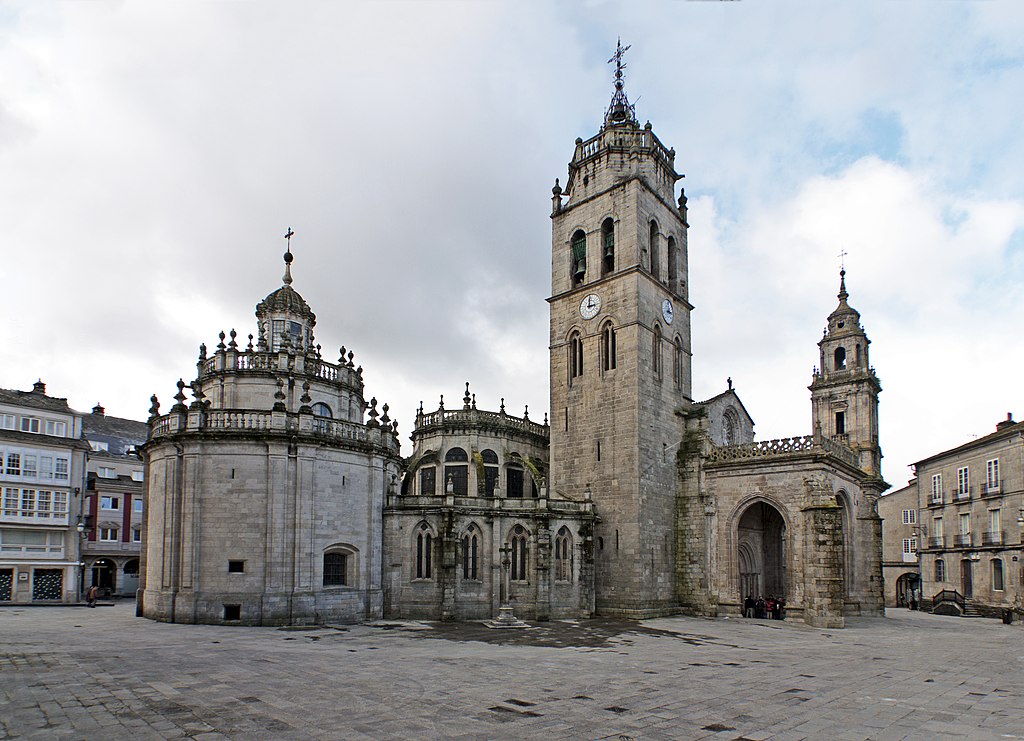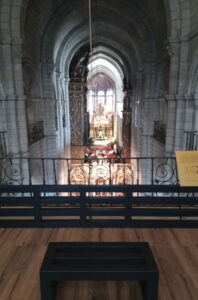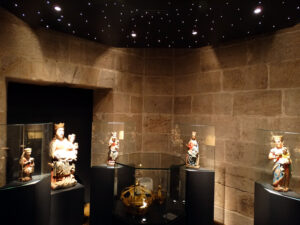
Cathedral of Santa María de Lugo. Photo: Antonio Costa.
The Museo Diocesano Catedralicio de Lugo was founded during the first quarter of the 20th century by the priest Alfredo Lorenzo López, with the Seminary of Lugo being its original location. This location changed at the end of the 20th century to the Lugo Cathedral, at which time the Diocesan Museum and the collection of the Cathedral of Lugo were united, originating the current Museo Diocesano Catedralicio de Lugo, being reopened after a reform in June 2017.
Currently this museum spans through the west area of the Basilica of Santa María de Lugo, mainly in the area of the Council of Canons Room and the clerestory, also using the base of the towers for the musealization of the collection of Romanesque and Gothic Virgins, as well as the warehouses, library and the archive of the museum itself.

Interior of the Cathedral of Santa María de Lugo. Photo: Diocese of Lugo.
The museum has seven different sections: the initial is named Ars Picta and includes the collection of paintings, highlighting the picture of the Presentation of Jesus in the temple of Zacarías González Velázquez, deposit of the Prado Museum. Equally relevant are the works of authors such as Vicente López or Antonio Villamor and objects such as the baton of the musician from Lugo Juan Montes Capón.
The next two zones take us back to the beginnings of the museum and its connection with archeology and the remains of the Roman era: The origins and God’s work includes pieces such as the votive altar of San Martiño of Curbián or the Crismón de Quiroga, a circular piece of marble dating from the 5th century a. C. The fourth section is From the new temple to the temple of the medieval with pieces such as the Cancel de Saamasas, the lion of the old facade of the Cathedral of Lugo, the relief of the Eucharistic Offering or sculpture of San Capito, traditionally the first bishop of Lugo. The views of the main section of the Cathedral from the clerestory in this area are impressives, establishing a symbiosis with the pieces that are presented there.
From which God sucked milk from his breast it is the fifth section of the museum and is located at the base of the north tower of the Basilica, in it there are images of Romanesque and Gothic Virgins as well as the crowns of the Nuestra Señora de los Ojos Grandes, Patron of the city of Lugo.
Hoc hic mysterium is the name of the sixth section of the museum, located on the north section of the clerestory and where there are gold and silver pieces of great patrimonial value: the chalice of Bishop Baamonde (15th century), the chalice of Archbishop Bartolomé de Rajoy (18th century), the custody of Bishop Diego Castejón Fonseca (17th century) or the crucified Christ attributed to Giambologna they are just a few examples of the wealth that this section presents to the public.
The last section of the Museo Diocesano Catedralicio de Lugo houses the collection of sculptures, highlighting the images of the four Evangelists from the old altarpiece of the Cathedral’s Main Chapel, work of Cornielles de Holanda from the 16th century, the set of the Runaway to Egypt, the work of Domingo de Andrade from the 17th century or the reliquary arm of San Froilán, a silver piece from 1614 that preserves the bone of San Froilán, a saint born in Lugo and Patron saint of the city itself.

Collection of Romanesque and Gothic Virgins at the Diocesan and Cathedral Museum of Lugo. Photo: Diocese of Lugo.
The Museo Diocesano Catedralicio de Lugo is framed within the lines of the Museums of the Church and reflects the interest of the Diocese of Lugo for its historical artistic heritage, its conservation and enhancement being key. This museum is closely linked to the ecclesial life of the Cathedral of Lugo, showing the collection the path of faith that this christian community has followed throughout the centuries, currently occupying an important role in the evangelizing mission of the Church in Lugo.
Conservation, custody, valuation, exhibition or diffusion are basic aspects on which the function of this museum institution is elevated, where the promotion of research, catechesis or helping to have a Christian reading of the pieces presented at the exhibition also play an important role.
The promotion, diffusion and enhancement of the heritage of the museum is oriented by various itineraries, such as social networks: the museum presents periodical publications in Twitter, Facebook, Instagram or Tiktok, being able to reach thousands of users from different parts of the world with each publication.
Heritage interpretation activities are frequent as a method of dissemination, either with guided tours or with “treasure hunt” activities, in both cases centralizing the activity on a single theme, such as Animals in the Cathedral of Lugo, the iconography of Santiago Apostle, Eucharistic iconography, The landscapes or funerary architecture in the Basilica of Santa María de Lugo. These activities are always developed adapted to the different dates of the year, being especially important in the case of Lugo the festivities of Corpus Christi, for the secular privilege of the Permanent Exhibition of the Blessed Sacrament on the High Altar of its Cathedral, as well as the Plenary Indulgence that can be obtained in it.
The Museo Diocesano Catedralicio de Lugo also tries to promote research, either through articles, such as those by Sánchez Milao, doctoral theses, such as that of Requejo Alonso or participation in congresses and symposiums, like the one presented in October 2022 at the University of Santiago de Compostela by Calles Lombao with the title The symbiosis between museum and cathedral: the Basilica of the Assumption of Mary of Lugo.
A group of visitors listening to their guide at the entrance of the museum. Photo: Diocese of Lugo.
Broadcasting through television, the radio or the local press is another of the resources used in the museum to promote its heritage and help to protect it, a fact that is endorsed by some well-kept facilities inaugurated in June 2017 and that have systems security such as cameras, sensors or alarms, as well as constant daily surveillance.
Since its reopening in 2017 the museum has opened hours that exceed 50 hours a week every day, maximizing the compatibility of the population’s schedules to favor people’s access to the museum.
The room staff, the audio guides, billboards or information displays helps to the connection with the public and make it possible that information arrives in the simplest way possible, enhancing the human aspect of the museum.
The more than 100 years of existence of the Museo Diocesano Catedralicio de Lugo have witnessed a constant evolution; from its origins in the Seminary of Lugo to the current museographic proposal, inaugurated in 2017, the entity has witnessed a growth that has placed it among the most visited museums in Galicia, exceeding 40,000 visitors during the year 2022, becoming a reference institution for the promotion and enhancement of the artistic and historical heritage of the Catholic Church on the north of Spain.
By Marcos Gerardo Calles Lombao, Director of the Diocesan and Cathedral Museum of Lugo.





Follow us: